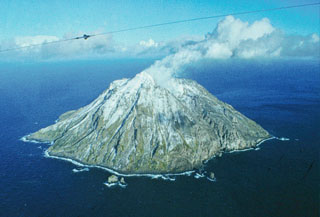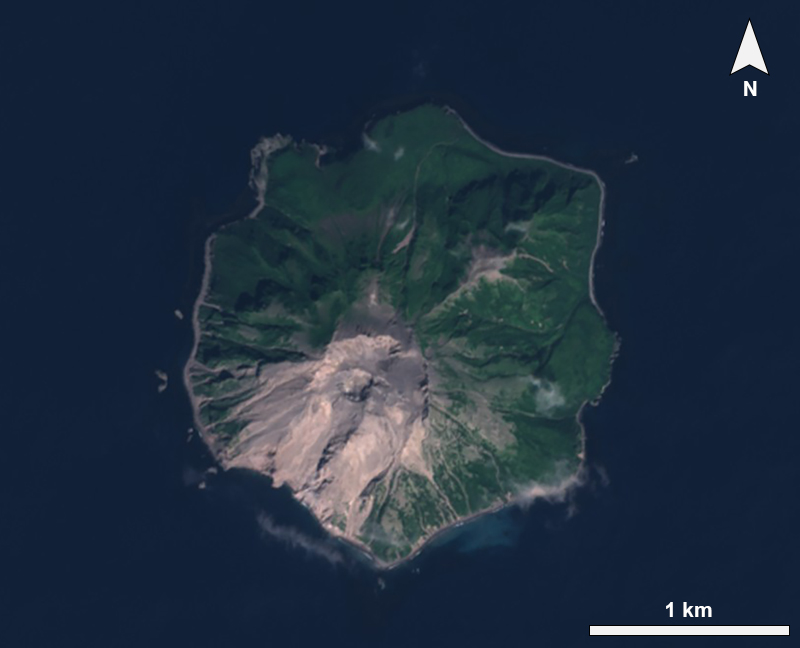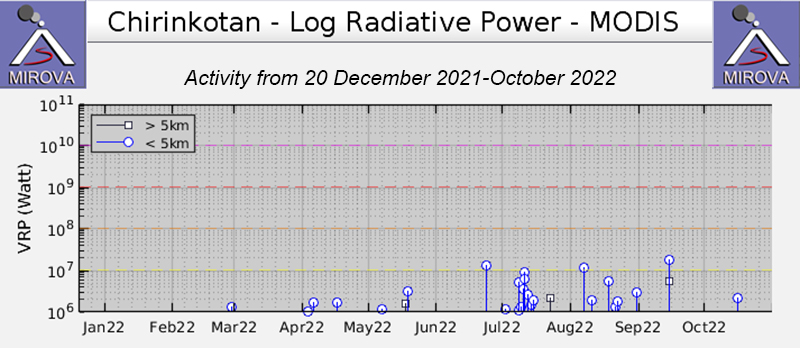Report on Chirinkotan (Russia) — November 2022
Bulletin of the Global Volcanism Network, vol. 47, no. 11 (November 2022)
Managing Editor: Edward Venzke.
Research and preparation by Paul Berger.
Chirinkotan (Russia) Ash plume identified in satellite images on 7 October 2022
Please cite this report as:
Global Volcanism Program, 2022. Report on Chirinkotan (Russia) (Venzke, E., ed.). Bulletin of the Global Volcanism Network, 47:11. Smithsonian Institution.
Chirinkotan
Russia
48.98°N, 153.48°E; summit elev. 724 m
All times are local (unless otherwise noted)
Chirinkotan is a 3-km-wide island volcano in the northern Kuril Islands about 320 km SW off the tip of Kamchatka, Russia (figure 9). Eruptions have been recorded since the 18th century and one confirmed eruption in the 19th century included lava flows. More recently, an eruption that began in late November 2016 consisted of intermittent ash plumes (BGVN 42:06), and activity during August-September 2021 was characterized by explosions and ash plumes. The volcano is monitored by the Sakhalin Volcanic Eruptions Response Team (SVERT) and by satellite data.
SVERT reported that an ash plume was identified in satellite images at 1030 local time on 7 October 2022 rising to an altitude of 3.5-4 km (2.8-3.3 km above the summit) and drifting 80 km ESE. The Aviation Color Code was raised to Yellow (the second lowest level on a four-color scale). Due to an absence of subsequent activity, SVERT lowered the Aviation Color Code back to Green (the lowest level on a four-color scale) on 10 October.
During the year ending in October 2022, Sentinel-2 satellite views of the volcano were usually obscured by weather clouds. When clear views were possible, white gas emissions were often visible, but no thermal anomalies were detected. The MIROVA (Middle InfraRed Observation of Volcanic Activity) system recorded a few scattered hotspots during the year 2022, with more anomalies during July and August 2022 (figure 10). No thermal alerts were recorded by MODIS sensors aboard the Aqua and Terra satellites and processed using the MODVOLC algorithm during the reporting period.
Geological Summary. The small, mostly unvegetated 3-km-wide island of Chirinkotan occupies the far end of an E-W volcanic chain that extends nearly 50 km W of the central part of the main Kuril Islands arc. It is the emergent summit of a volcano that rises 3000 m from the floor of the Kuril Basin. A small 1-km-wide caldera about 300-400 m deep is open to the SW. Lava flows from a cone within the breached crater reached the shore of the island. Historical eruptions have been recorded since the 18th century. Lava flows were observed by the English fur trader Captain Snow in the 1880s.
Information Contacts: Sakhalin Volcanic Eruption Response Team (SVERT), Institute of Marine Geology and Geophysics, Far Eastern Branch, Russian Academy of Science, Nauki st., 1B, Yuzhno-Sakhalinsk, Russia, 693022 (URL: http://www.imgg.ru/en/, http://www.imgg.ru/ru/svert/reports); MIROVA (Middle InfraRed Observation of Volcanic Activity), a collaborative project between the Universities of Turin and Florence (Italy) supported by the Centre for Volcanic Risk of the Italian Civil Protection Department (URL: http://www.mirovaweb.it/); Sentinel Hub Playground (URL: https://www.sentinel-hub.com/explore/sentinel-playground).



